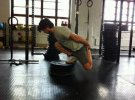LoneRider
Level 6 Valued Member
I'll be undergoing a big change next summer as I prepare to move from Hawaii and back to Florida to be nearer to my family as I transition from Active Duty to Reserve service. As such I've been looking heavily into bodyweight training methods for that time where my household goods (including my kettlebells) are in storage and the like. I immediately read into my copies of Naked Warrior and Beyond Bodybuilding's chapter on calisthenics. In particular I've been reading and re-reading the section detailing tension and grease the groove in Naked Warrior in particular.
@Neuro-Bob posted this article about the pistol (linked here) that I found as excellent food for thought. I have a clean bill of health in terms of joints and the like and have good form for the squat/front squat in terms of the article's pre-requisites. As to the 100 consecutive bodyweight squats, I've not tested that yet, and that might be the first bodyweight only session I do as a baseline.
When it comes to single leg exercises I've found lunges to be easier for a whole host of reasons to be easier than pistols or attempting them has been for me. In my Muay Thai class we use a lunge variation as part of our post pad-work conditioning drills that emphasizes an upright stance, keeping the core 'zipped up' and the like.
Since I find lunges easier to execute I might start in with getting proficient on the airborne lunge as my first real foray into single leg work. I've been curious about the Airborne Lunge as a way to drill single leg movements. Is it transferrable to the pistol?
@Neuro-Bob posted this article about the pistol (linked here) that I found as excellent food for thought. I have a clean bill of health in terms of joints and the like and have good form for the squat/front squat in terms of the article's pre-requisites. As to the 100 consecutive bodyweight squats, I've not tested that yet, and that might be the first bodyweight only session I do as a baseline.
When it comes to single leg exercises I've found lunges to be easier for a whole host of reasons to be easier than pistols or attempting them has been for me. In my Muay Thai class we use a lunge variation as part of our post pad-work conditioning drills that emphasizes an upright stance, keeping the core 'zipped up' and the like.
Since I find lunges easier to execute I might start in with getting proficient on the airborne lunge as my first real foray into single leg work. I've been curious about the Airborne Lunge as a way to drill single leg movements. Is it transferrable to the pistol?

